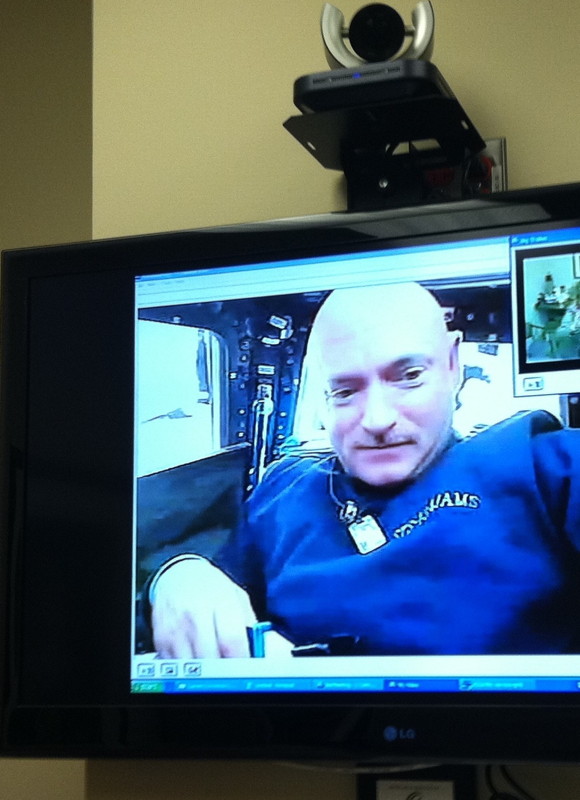Astronaut Husband of Rep. Giffords Eager to See Her After Spaceflight

Flying on space shuttle Endeavour's last mission was the right call for astronaut Mark Kelly, despite the flight's conflict with his wife, Congresswoman Gabrielle Giffords', brain surgery, the veteran space commander said Monday. He has no regrets and he can't wait to see his wife after landing, he added.
Giffords, D-Ariz., was shot in the head during an assassination attempt on Jan. 8 outside a Tucson grocery store. Her husband was preparing to command the STS-134 mission of NASA's space shuttle Endeavour, that orbiter's final flight before being retired.
"When January 8 happened, when that day came, it didn't look likely that I would be on this flight," Kelly said from space late yesterday (May 30) during a series of televised interviews. "But her recovery went well enough, and things lined up with her being able to go to rehab in Houston, that I was able to rejoin my crew and complete this mission." [Wounded Rep. Giffords: Shuttle Launch Is 'Good Stuff']
A family decision
Kelly originally took some time off to be with his family, but went back to training for the shuttle mission in February as Giffords' condition improved. Giffords has been recovering at The Institute for Rehabilitation and Research (TIRR)-Memorial Hermann hospital in Houston.
"I don't have any regrets," Kelly said. "There were periods of time over the last 16 days where you miss your wife and your kids, and I think that’s true for all of us, but in hindsight, it was absolutely the right decision."
What's the first thing he'll tell her after landing? That’s simple, Kelly said.
Breaking space news, the latest updates on rocket launches, skywatching events and more!
"Probably, 'I'm back,'" he said.
Kelly's focus on the mission, while compartmentalizing his concern for his wife at home, might have gotten more difficult two days into the flight, when Giffords underwent brain surgery on May 18.
Giffords underwent cranioplasty surgery to replace a portion of her skull that was removed with a plastic implant. The bone had originally been removed to allow her injured brain room to swell, but the procedure was timed to help her heal now that she has made significant progress in recovery.
Kelly said the decision to time the surgery for during his mission was a good call, too.
"She was ready for the surgery," Kelly said. "The timing worked out where her doctor ideally wanted to do it soon after I launched, and I really trust him, and her mom was there and her dad and other family members. It was good timing so I didn’t want to hold it up by this spaceflight, so we decided to go ahead with it and in hindsight it was absolutely the right decision."
Endeavour's last hurrah
Kelly and his five crewmates spent about two weeks at the International Space Station delivering a $2 billion particle physics experiment and a set of backup parts for the orbiting outpost. Four spacewalks were performed. [Stunning Spacewalk Photos of Endeavour at Station]
The astronauts undocked from the station on May 29, and plan to land back at Kennedy Space Center in Cape Canaveral, Fla., on Wednesday (June 1) at 2:35 a.m. EDT (0635 GMT).
During his flight, Kelly has been able to email and call his wife on the phone, and even got to share views of the Earth from space during a video chat with her.
Kelly's focus on the mission, while compartmentalizing his concern for his wife at home, might have gotten more difficult two days into the flight, when Giffords underwent brain surgery on May 18Giffords underwent cranioplasty surgery to replace a portion of her skull that was removed with a plastic implant. The bone had originally been removed to allow her injured brain room to swell, but the procedure was timed to help her heal now that she has made significant progress in recoverKelly said the decision to time the surgery for during his mission was a good call, too.
"She was ready for the surgery," Kelly said. "The timing worked out where her doctor ideally wanted to do it soon after I launched, and I really trust him, and her mom was there and her dad and other family members. It was good timing so I didn’t want to hold it up by this spaceflight, so we decided to go ahead with it and in hindsight it was absolutely the right decisionAll in all, Giffords' recovery has been going extremely well, according to Kelly and her doctors.
In fact, she was well enough to travel to Florida twice for Endeavour's two launch attempts, including the second, successful, try May 16 that sent the shuttle into space. [Wounded Rep. Giffords: Shuttle Launch Is 'Good Stuff']
"To have her and Claudia and Claire, my two daughters, there, it was really a special moment," Kelly said. "After what happened to her on January 8, the fact that she was able to recover to the point to walk on the airplane, walk off, make the trip to Florida twice. Being away from her, to be honest, it's difficult. Fortunately there's a phone on the space station, there's email, we can communicate, and I'm looking forward to getting back there tomorrow."
You can follow SPACE.com senior writer Clara Moskowitz on Twitter @ClaraMoskowitz. Visit SPACE.com for complete coverage of Endeavour's final mission STS-134 or follow us on Twitter @Spacedotcom or Facebook.

Clara Moskowitz is a science and space writer who joined the Space.com team in 2008 and served as Assistant Managing Editor from 2011 to 2013. Clara has a bachelor's degree in astronomy and physics from Wesleyan University, and a graduate certificate in science writing from the University of California, Santa Cruz. She covers everything from astronomy to human spaceflight and once aced a NASTAR suborbital spaceflight training program for space missions. Clara is currently Associate Editor of Scientific American. To see her latest project is, follow Clara on Twitter.
